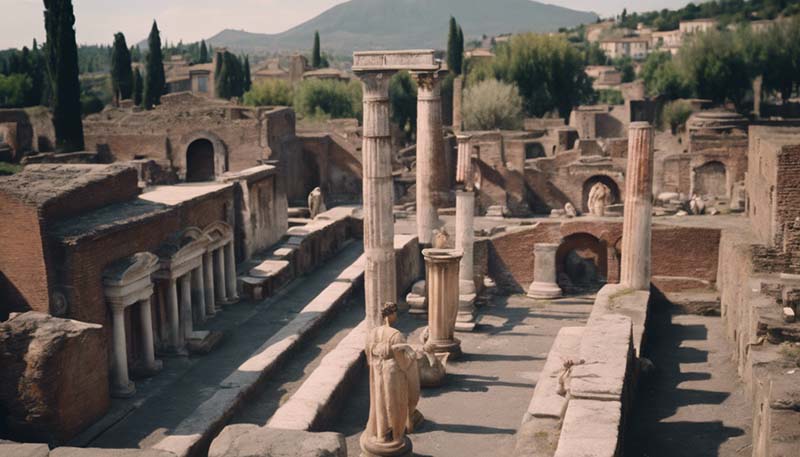The Ancient City of Pompeii: A Snapshot of Roman Life
Welcome to the ancient city of Pompeii, a well-preserved Roman city that offers a unique glimpse into the daily life of ancient Romans. Located near modern Naples, Pompeii was a thriving city until the catastrophic eruption of Mount Vesuvius in 79 AD, which buried the city under a thick layer of volcanic ash and pumice. This tragic event, however, has given us a priceless snapshot of Roman life, frozen in time for us to explore and learn from.
History of Pompeii
Pompeii was founded by the Osci, an ancient Italic people, in the 6th century BC. It later became a Roman colony in 80 BC after the Social War. The city was known for its vibrant culture, thriving trade, and strategic location. It was home to about 20,000 people at the time of the eruption.
Advertisement
The Eruption of Mount Vesuvius
On August 24, 79 AD, Mount Vesuvius erupted with a force that dwarfed any volcanic eruption in recorded history. The eruption lasted for two days and released a deadly combination of ash, rock, and toxic gases. The residents of Pompeii were caught unaware and were unable to escape the fast-moving pyroclastic flows that engulfed the city.
Rediscovery and Excavation
The city was lost for over 1500 years until its rediscovery in 1748. Since then, extensive excavations have been carried out, revealing a city that is remarkably well-preserved. The ash and pumice that covered Pompeii acted like a time capsule, preserving buildings, artifacts, and even the victims of the eruption.
Architecture and Urban Planning
Pompeii's urban layout reflects the typical Roman design, with a grid of streets, a forum, temples, bathhouses, and a theater. The city was well-planned, with an efficient system of water supply and drainage. The buildings were constructed using a combination of stone, brick, and concrete, and were often adorned with frescoes and mosaics.
Daily Life in Pompeii
The homes in Pompeii, known as domus, were typically two-story buildings with a central courtyard. They featured living spaces, kitchens, and workshops. The city was also home to numerous thermopolium, which were ancient fast-food joints serving wine, snacks, and hot meals.

Food and Drink
The diet of the Pompeians was diverse and included fruits, vegetables, grains, and seafood. Evidence of food preparation and consumption has been found in many homes and restaurants. Wine was a staple drink, and the city had its own vineyards and wine production facilities.
Entertainment and Leisure
Pompeii was a city that valued leisure and entertainment. The city had a large amphitheater that hosted gladiator fights and other spectacles. There were also several bathhouses that provided a place for socializing and relaxation.
Art and Culture
The city was rich in art and culture, with numerous examples of frescoes, mosaics, and sculptures found throughout the city. The Pompeians were also known for their love of music and theater, with many homes and public spaces equipped for performances.
Pompeii Today
Today, Pompeii is a UNESCO World Heritage Site and one of the most popular tourist destinations in Italy. Visitors can walk through the ancient streets, explore the homes and public buildings, and gain a unique insight into the life of an ancient Roman city.
Conclusion
The Ancient City of Pompeii offers a fascinating snapshot of Roman life. It is a testament to the resilience and ingenuity of the Roman people, and a poignant reminder of the power of nature. The city continues to reveal new discoveries and insights, making it an invaluable resource for historians, archaeologists, and anyone interested in the ancient world.
Thank you for exploring the ancient city of Pompeii with us. We hope this journey through time has been as enlightening for you as it has been for us.
Comments